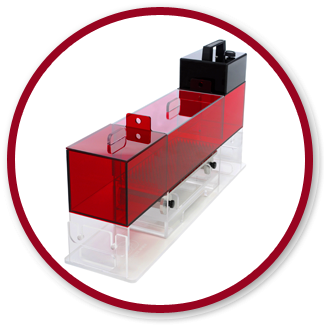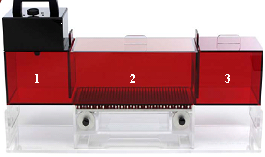
Operant Algesiometers
Operant Conflict-Avoidance System (OCS)
The OCS provides an operant method of pain testing with rodents that complements reflexive methods by addressing cognitive and motivational processing.
This operant behavioral system consists of a 3-chambered red acrylic unit where chamber 1 contains an aversive bright light, chamber 2 is darker with a textured floor or heated/cooled floor as the stimulus (variable from innocuous to noxious), and chamber 3 is dark (safe haven). Rodents are given the opportunity to escape the bright light by crossing chamber 2 to the “rewarding” dark chamber. Dependent measures are related to the perceived or actual noxious input evoked by the stimulus; exit time from chamber 1 (emphasizing the cognitive components of pain) and duration in chamber 2 (emphasizing the sensory component of pain).
Use three interchangeable stimuli to test multiple pain models with one device
- Mechanical
- Heat
- Cold
Simple adaptations allow a single OCS to be used for both rats and mice.
Features and Benefits
- Easy to disassemble/assemble for transport and cleaning
- Constructed from durable acrylic
- Compact enough to allow multiple units in one
- Testing is faster than other operant methods (most MCS tests are completed in less than 1 minute)
- Complements reflexive methods
- Adaptable to other stimuli beyond mechanical and light lab
- Animal training is fast and simple
- Red color enables researcher observation while rats perceive it as black/dark
Bright light (1) serves as the aversive stimulus for test initiation. Animals can cross an array of nociceptive probes (2) to reach a preferred dark compartment (3)
Publication Utilizing the MCS
Lau, D., Harte, S.E., Marrow, T.J., Mata, M., Fink, D.J. (2012) Herpes Simplex Virus Ve Mediated Expression of Interleukin-10 Reduces Below-Level Central Neuropathic Pain After Spinal Cord Injury. Neurorehab Neural Repair: September 2012 vol. 26 no 7: 889-897
| Dimensions | 32.2 x 8.25 x 17.75 (inches) |
| Power Requirements | 24 Watts |
| 120v AC 60Hz* | |
| Probe Height Increments | 0.5, 1, 2, 3, 4, 5 mm |
| Accuracy of probe height above base | +/- 0.5mm (across entire array) |
| Light Output (Avg.) | 500-600 foot –candles |
| *optional transformer available for use with 220v, 50Hz | |
| Primary Materials of Construction | · Acrylic
· Polycarbonate · Stainless Steel Probes on Aluminum support plate |

